
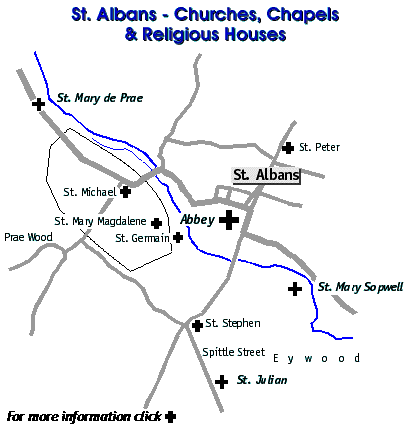
|
|
|
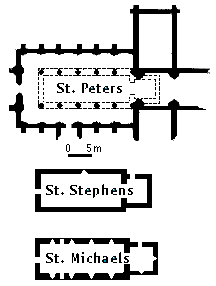
|
According to the Abbey chronicler, in the year
948, Abbot Ulsinus (or Wulsin) built the the
churches of St. Peter,
St. Stephen and St.
Michael at the entrances to the town. The
chronology of the Saxon Abbots is difficult to
establish but the recorded sequence makes more
sense if Ulsinus abbacy was earlier than 948, with
a floruit for him of 860-870. However, the core
both St. Michael's and St. Stephen's consists of a
Late Saxon Church of remarkably similar size and
plan. Although it is perhaps possible that these
churches could date from 948 a later date around
the end of the 10th, beginning of the 11th. century
seems more likely. Of course the earliest existing
work may not be the earliest church and at St.
Stephen's excavation has suggested that there may
well have been a timber structure preceding the
Late Saxon church although the purpose of this
remains uncertain.
|
|
Plans showing the earliest phases of St.
Michael's and St. Stephen's and how a similar sized
church would fit the plan of St.
Peter's.
|
|
|
|
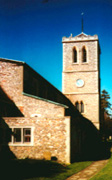
St. Michael's today
The Tower was built in
1896
|
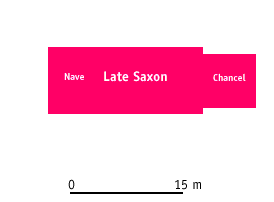
Schematic plans showing
the Medieval development of the
Church
|
|
The original Late Saxon church, built c.1000
consisted of a nave and chancel.
In Norman times the church was enlarged with the
provision of aisles to the nave; the northern being
the first built.
In the Thirteenth century the Lady Chapel and
probably the south porch were added. Lancet windows
of the Early English style were used in the chapel
and also in the clerestory of the nave.
In the Fourteenth century the the east wall of the
chancel was rebuilt (the present window in
Decorated style is a modern copy) and parts of the
side walls wee also rebuilt. The chancel arch was
rebuilt and later in the century the western window
in the south wall was inserted.
Three of the lancets in the north clerestory were
replaced in the early Fifteenth century and were
probably the work of Thomas Wolvey the architect of
the St. Albans clockhouse. He was also responsible
for the Fifteenth century tower (which may have
replaced an earlier one) unfortunately demolished
at the end of the Nineteenth century. Wolvey is
buried somewhere in the church. Later Fifteenth
century windows occur in the south wall of the lady
chapel and internally at its north east corner is
the blocked stair leading to a rood loft. Set above
this loft, partly on wooden boards infilling the
top of the chancel arch, a picture of the
Doom (the Last Judgement) was painted. Other
Fifteenth century windows occur in the south wall
of the chancel and in the north aisle (2).
The church was restored in the later Nineteenth
century, carefully by Sir Gilbert Scott and with
enthusiasm by Lord Grimthorpe. The latter modified
the church by demolishing the tower and extending
the nave to the west. A new tower was built at the
west end of the north aisle. A new vestry was built
where the south aisle had once been. Another vestry
was added to the north side of the church in
1937.
|
The St. Michael's
Doom
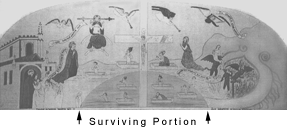
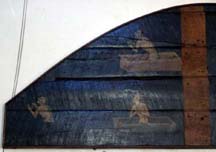
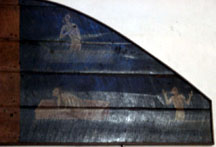
Top- Drawing made after the discovery of
the painting in 1808
Bottom - Details of the surviving portion
painted on oak boards
In 1808 a Fifteenth century painting of the
Doom was discovered over the chancel arch and on
boards infilling the top of the arch itself.
Unfortunately only the portion painted on the oak
boards survives but this is an extremely rare
survival. Fortunately a drawing made at the time of
discovery records the missing portion of the
painting so that the alternatives of salvation or
damnation gazed at by the medieval congregation can
still be appreciated.
|

|
St.
Peters
One of the three churches which the
Abbey tradition claimed were built by
Abbot Ulsinus. Like the two other of his
churches this served a large rural parish
but also provided for a large part of the
town. (An area much larger and more
populated than that part of the town in
St. Michael's parish). This church has
been much more drastically altered than
St. Stephen's and St. Michael's. By the
end of the 18th century it was in a very
bad condition and in 1799 part of the
tower was taken down; in 1801 the belfry
floor collapsed and in that year the
transepts were demolished and the chancel
shortened. The existing building results
from the "indefatigable" Lord Grimthorpes
"restoration" of 1893. However it is clear
that in the 15th century it was much
bigger than the other churches with a
cruciform plan with large transepts and
along eastern arm; very much a town
church.
The parish originally included, as
chapelries, Sandridge, St. Andrew (in the
town) and Ridge, which were made into
separate parishes in the 14th century. In
1119-46, Abbot Geoffrey granted the use of
the church revenues to the Abbey Infirmary
and in 1252 Abbot John instituted a
vicarage. The Infirmarer then became
rector and as such was required to supply
the monks wine from the revenue of the
church. If he failed in this obligation he
was fined 8s. (40p.) for each day
missed!
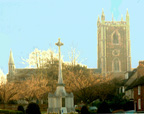
St. Peters
Church
|
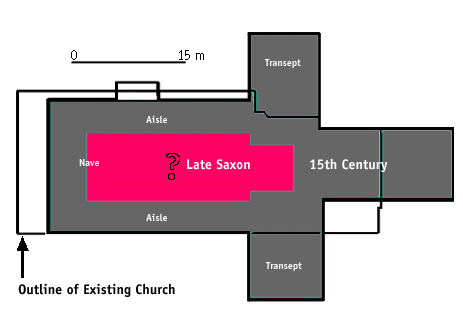
|
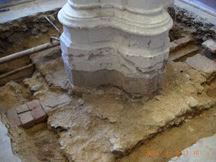
The 2001
excavation
In 2001 a small excavation was
undertaken which showed that one of the
Fifteenth century columns sat on a
possibly earlier foundation, which itself
cut an earlier east-west wall. This wall
was probably the original north wall of
the nave and therefore probably of Late
Saxon date although there was no direct
evidence for its date.
|
|

|
|
|

|
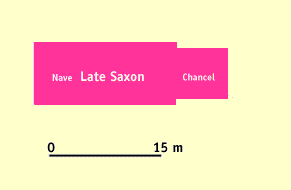
Schematic plans showing the Medieval
Development of St. Stephen's
Church
St. Stephen's followed a similar course of
development to St. Michael's. The original late
Saxon building consisted of a nave and chancel to
which aisles were added but here the south aisle
was not added until the Thirteenth century and was
integral with the building of the lady Chapel. The
north wall of the north aisle has been located by
excavation, although little of it remained. This
was not dated but as the church was consecrated
between 1101-1118 it was almost certainly built
before that date. This north aisle was demolished
in the Fifteenth century.
Left - The north wall of St.
Stephen's showing a Late Saxon Window cut by the
arcading of the added Norman aisle. The modern
extension is entered through a Fifeenth century
doorway built after the demolition of the
aisle.
|

|
An oratory to St. Germain (or Germanus) of
Auxerre was built in the time of Abbot Eadfrith
(c.840-860). This is said to have been built
on the site of a chapel, then ruinous and deserted,
which had been built where the house was in which
St. Germanus stayed in 429 during his visit to
Verlamium to combat the Pelagian heresy. Wulf a
Dane was installed as a hermit and was suceeded by
Eadrith after his resignation from the abbacy. The
Chapel was dedicated in 1108-15 and was repaired in
1326-35. It seems likely that the survivng fragment
of Roman city wall known as 'St. Germains block'
owes its survival to the fact that it was once
incorporated in this chapel.
At the dissolution the chapel along with Mary
Magdelene passed to Sir Richard Lee.
This oratory was built by Abbot Wulsin (c.
860-880) and a chapel of St. mary Magdalene was
dedicated in 1094-1119. There was still a hermit in
residence in 1530. After the dissolution the
property was described as a chapel with a mansion
and land adjoining, it was leased to Sir Francis
Bryan in 1541 and granted to Sir Rivchard lee in
1547.
|
|
Three of the Abbey's daughter
houses or cells were situated close to the
town.
|
|
|
|
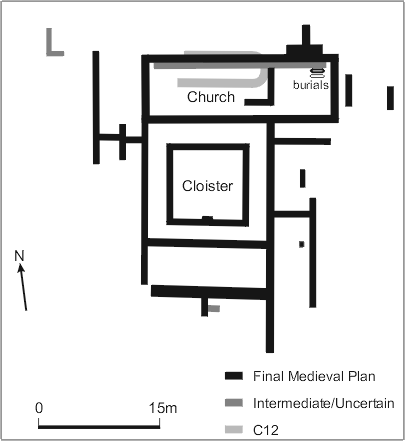
Plan of Sopwell Priory as
Revealed by Excavation
(after
Johnson)
The priory of St. Mary of Sopwell was said by
Matthew Paris to have been founded by Abbot
Geoffrey (1119-46) and this house was probably
established to house the nuns who had existed at
the Abbey itself until around this date.
In 1428 the famous robber captain William Wawe
and his band broke into Sopwell expecting to find
there Eleanor Hulle a lady of some influence at the
royal court. While they were plundering the hue and
cry was raised by a man in the "village". This
suggests that there was occupation near to the
priory presumably at its gates, on Sopwell Lane
outside the town, or at Greenlane End.
In 1537 the house was dissolved under the
Act of the previous year and the site was granted
to Sir Richard Lee. He adapted the buildings for
domestic use but later built a new house on the
site. It is the remains of this house which are
known today as the Nunnery Ruins or Sopwell
nunnery. The "barns of the cell" with which the
priory's agricultural land was provided are still
remembered in the Cell Barnes area of St.
Albans.
|
|
The Hospital of St. Mary de Pre was founded by
Abbot Warin who in 1194 granted to the monastery
the place in which their church was built together
with the conventual buildings on either side of
Watling Street. Its cemetery was consecrated in the
period 1214-35. At first Pre was ruled by a Master
and was a hospital for leprous nuns but as leprosy
died out its role changed and it became an ordinary
priory in the mid fourteenth century.
In 1528 an inquiry found that the prioress had
died and that the three nuns which comprised the
convent had left. The priory was dissolved by Pope
Clement VII and annexed to St. Albans Abbey, then
held by Cardinal Wolsey. In the July Henry VIII
granted the site of the former priory and its lands
to Wolsey himself who conferred it on his new
Oxford college. After his downfall Wolsey's lands
were seized by the king and Pre was leased to a
London merchant and in March 1530, for a term of 30
years, to Richard Raynshaw, yeoman of the King's
Guard. In 1531 King Henry swapped Pre with the
Abbot of St. Albans. When the Abbey was dissolved
the site of the priory was granted to Sir Ralph
Rowlatt.
The site of St. Mary de Pre has twice been
disturbed by the digging of pipe trenches which
revealed wall foundations and the outlines of
buildings show on aerial photographs. One of the
buildings remained standing until well into the
Eighteenth century.
|
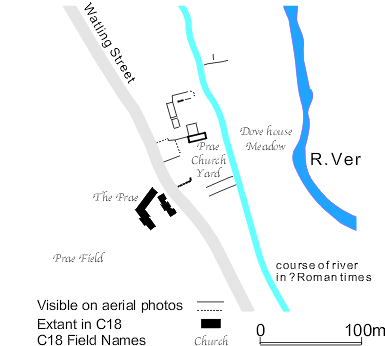
Plan of the remains of St. Mary de
Pre
|
|
The Hospital of St. Julian, for leprous men, was
founded by Abbot Geoffrey (1119-46) on a plot of
land along side Watling Street known as Kingesho.
King Henry II granted the lepers the sum of 1d a
day in perpetuity and from 1160 the annual sum of
30s 5d was paid to them by the Sheriff of
Hertfordshire. in 1344 it was decreed that in
future there should be 6 lepers and priority was to
be given to monks of St. Albans and those born
within the jurisdiction of the Abbey. Married men
were only admitted if also adopted a religious
life, so freeing the husband from the tie of
marriage.
In 1505 after a dispute over the mastership of the
hospital it was annexed to St. Albans.
Nothing is known of the archaeology of this
hospital but there is in the St. Albans Museums
collections the skeleton from a burial found during
building works close to the corner of Vesta Avenue
and Watling Street which no doubt came from its
cemetery.
The name St. Julians is still in use as an area
of the modern city.
|
|